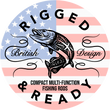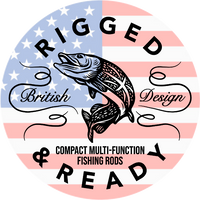Choosing the Perfect Fishing Hook: Expert Tips for Beginners

“Tight lines, a sharp hook, and the drag set correctly — that’s the difference between returning home with a smile on your face or with a story about the one that got away.”
You’ve been waiting all winter to go fishing. You’ve watched all the YouTube videos you can without arguing with your wife. The day is perfect — the sun is shining, it’s warm. You’ve set up, baited the line, and made a cracking cast. But then nothing.
Or worse, the one that took your bait wriggled free. Chances are that your hook was the problem. Maybe it's too small. Maybe it was too small. Maybe it's too flimsy. The tip could be blunt, or just the wrong type altogether.
If you’re just getting started, it’s easy to get overwhelmed by hook sizes, wire gauges, and all the talk of aughts and barbs. That’s where we come in. At Rigged & Ready, we believe in keeping things simple — because the right fishing hook sizes can make or break your day on the water.

Perfect hook, perfect catch – crappie couldn't resist this tiny treat!
This guide will walk you through fishing hook sizes, help you understand a hook size chart, and explain how to choose the right one for both the fish and the style of fishing you’re doing — whether it’s river trout or surfcasting for redfish.
Hook Sizes 101: Cracking the Code
Let’s start with the bit that trips up most beginners: fishing hook sizes are not like your shoe size. In fact, it’s kind of the opposite.
The smaller the number, the bigger the hook. So a size 2 is larger than a size 10.
Consider adding a clarification here: This system can confuse beginners, but once understood, it’s a vital part of choosing the correct fishing hook sizes for various species. A 4/0 is bigger than a 2/0.

Here’s a quick hook size chart to give you the lay of the land:
| Hook Size | Best For |
|---|---|
| 16 - 24 | Match fishing or catching live bait. |
| 8 – 14 | Small species: perch, roach, trout & carp. |
| 2 – 1/0 | Bass, walleye, bream. |
| 2/0 – 6/0+ | Pike, zander, catfish, saltwater fish i.e Cod, Smooth Hounds and Rays |
Pro Tip: Fishing hook sizes can vary slightly between brands, so always match your hook to your bait. The hook point must stay exposed — if it’s buried in bait, it can’t do its job.
Hook Types Explained: Matching Design to the Job
It’s not just about hook sizes — the type of hook matters too. Here's a breakdown of popular styles and what they’re best for:
- J-Hooks: Classic all-rounder. You’ll need to strike to set the hook. Great for bass and trout.
- Circle Hooks: Are designed to hook fish in the corner of the mouth - no deep hooking - making them ideal for catch and release. Let the fish hook itself — no strike needed.
- Treble Hooks: Three-pronged power. Common on lures, but not the best for fish welfare.
- Bait Holder Hooks: Extra barbs to keep worms or cut bait secure. Handy for bottom fishing or carp.
- Worm Hooks (Wide Gape): Offset to rig soft plastics weedlessly — a bass angler’s go-to.
- Weedless Hooks: Weedless hooks are designed with guards or bends to prevent snagging on weeds or debris, allowing you to fish effectively in heavy cover while still hooking fish cleanly when they strike
Matching Hook to Species
The best hook size depends on your target fish’s mouth size and feeding behaviour. If in doubt, go slightly larger — a hook that’s too small may bend or fail during the fight. Big doesn’t always mean better, but it does often mean stronger.

Match the hatch, use whatever the fish are feeding on.
Pro Tip: Control is everything. Hook choice matters, but playing a fish well is what gets it to the net.
The Hidden Details: Wire Gauge, Materials, and Barbs
Wire Thickness:
- Thin wire = stealthier, great for clear water or shy fish.
- Thicker wire = more strength for hard fighters like pike or catfish.
Materials:
- Carbon steel hooks are affordable but prone to rust in saltwater.
- Stainless steel is corrosion-resistant — ideal for sea fishing.
Barbs vs Barbless:
The old-school thinking was that barbless hooks meant missed fish. That idea's outdated. These days, the smart angler knows it’s all about control while playing the fish, not relying on a barb. Barbless hooks make catch and release much easier, reduce injury to the fish, and in many waters, they’re actually required. Catch and release is our preferred method allowing us to enjoy the sport of catching the fish, allowing it to return, grow and breed and one day it might return to your net as a personal best.

Barbless and kind – landed this chunky bass, released to fight again!
Whilst we are talking about catch and release make sure you have the appropriate tackle to unhook the fish safely and also to be able to remove a hook that you’ve found in the fish where it has gotten away from another angler, also an antiseptic spray is good to have in your box if you catch a fish with and injury or an injury has been caused by you playing the fish.
Smart Tips for Hook Success
- Carry a variation of hook sizes in your box, especially if you are fly fishing. Somedays fish are so wary that they will only take bait / fly if it is the same size as what they are feeding on.
- Match Bait to Hook: Small hooks for maggots and insects, medium for worms and corn, large for fish chunks or boilies.
- Adapt to the Water: Use weedless hooks in heavy cover, circle hooks for live baits
- Have various method of attaching your bait to the hooks from hair rigs, bait elastic, bands for pellets, it really depends on your method and your target species.
- Know the Rules: Some fisheries ban barbed hooks or require certain materials for conservation reasons. Also, the size and breaking strain of the hook length matter — always check first.

Big lure, big trebles – geared up to tempt a pike.
Final Word: Hook Smart, Fish Smarter
Getting the perfect hook isn’t guesswork — it’s know-how. With a solid understanding of fishing hook sizes, types, and materials, you’re already ahead of the game. Combine that with good fish-handling practices and the right technique, and you’ll spend less time scratching your head and more time landing fish.
At Rigged & Ready we’ve got the gear to match your ambition — from beginner to pro. Check out our full range of hooks and travel fishing gear designed to make every cast count.






